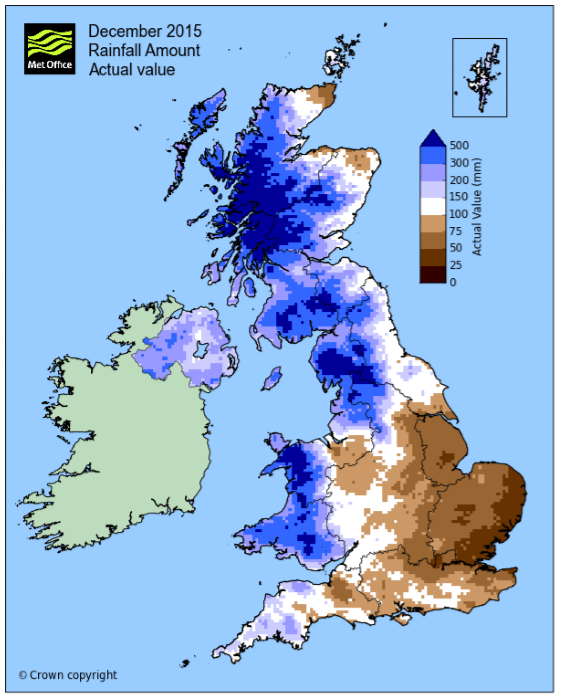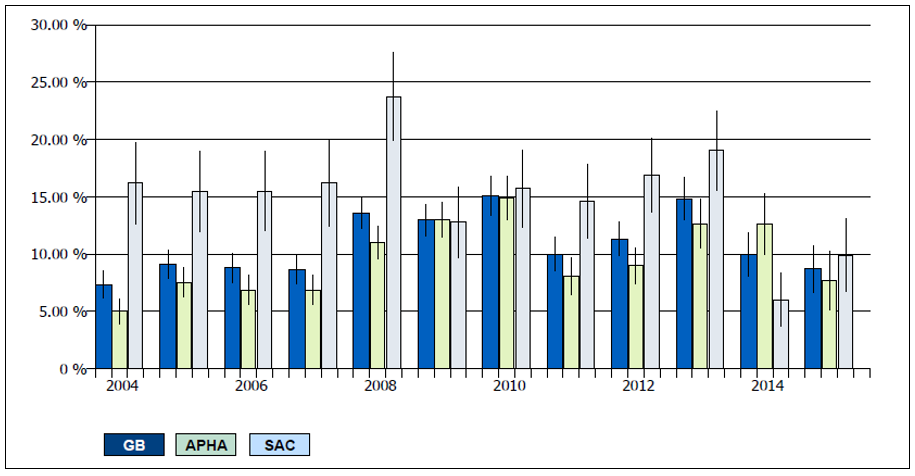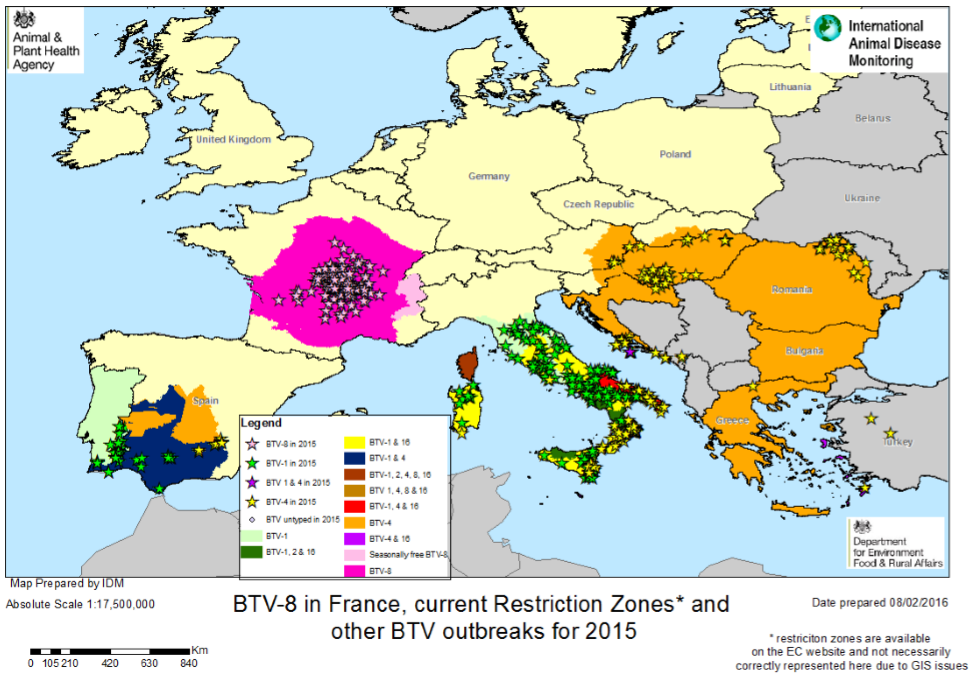



Cattle Disease Report: UK Situation, Unusual Cases and Emerging Threats
This 'Emerging Threats' report from the UK's Animal and Plant Health Agency (APHA) looks at herd size, current economic situation and disease cases in the UK's beef and dairy farms, using data from the end of 2015.Meteorology
- Severe flooding events in Cumbria and widespread areas of Scotland triggered by high two day rainfall on saturated ground (Fig 2) has caused local to regional difficulties for farmers such as access to stock, availability of forage and infrastructure damage (bridges, fences etc) which are causing short to medium term severe problems
- A warmer winter with mean temperatures across the period around a degree warmer than the 30-year period (Fig 1) could have implications for overwintering of vectors of vector-borne disease should this trend continue.

Beef quarter four and annual summary
According to the Defra Farming Statistics released in October, there was an increase in the beef breeding herd of 0.5 per cent, from 1.569 million to 1.577 million for the UK as a whole.
The current figure still represents a fall of 200,000 head in the UK beef herd over the last decade.
The future for the beef industry still looks uncertain, with possible reductions in the CAP payments and possibly reduced access to environmental stewardship payments for beef farmers. This uncertainty will affect farmers’ ability to invest in health schemes and eradication plans for diseases such as BVD and Johne’s disease.
As reported in the last quarterly report, further pressure on beef farmers has come from an increased supply of dairy cows being culled and slaughtered from dairy herds, because of the continued low price of milk, and in order to avoid the cost of winter feeding and housing.
Farmers in the North West of England have seen some government support following the extensive flooding experienced in December.
British Cattle Movement Service data indicated an increase in beef-sired calf registrations in 2015. This was 36,000 more for the first seven months of 2015 compared to the same period in 2014. If this trend continues, it will mean a modest increase in supply of beef animals coming to the market in 2016.
The average deadweight price of steers at the end of the year was 335.5 p/kg, which was down on the previous quarter by about 10p/kg.
Dairy
The last quarter of 2015 showed milk prices still falling across most contracts. Of concern is that milk production has continued to rise above 2014-15 levels with no quota limitations, no disincentive to expansion and with some producers trying to maximise returns on fixed costs.
An EU report ‘Prospects for EU agricultural markets and income 2015 – 2025’ does predict a slow recovery for the dairy sector to 2020 so farmers are having to adapt to an era of low returns in the medium term.
Increased numbers of cull dairy cows were traded in the last quarter of 2015 with producers removing unproductive cows to improve efficiency.
Given that cow health and productivity is optimised when accommodation is understocked by between 5 and 10 per cent this removal of cull cows may have been realised without a significant reduction in milk production.
Veterinary involvement in the dairy sector is continuing to come under pressure depending on individual farmer contracts and financial performance.
This may impact on the individual treatment and investigation of clinical cases and therefore surveillance; however, routine involvement in preventative health measures is accepted as a cost effective by many producers.
New and Re-Emerging Diseases and Threats
The threat summary for cattle 2015 provides information on the threats to cattle identified by the Cattle Expert Group (CEG) over the 12 months of 2015.
Thirteen threats were identified in 2015, nine were threats which are present in GB cattle.
Ongoing New and Re-Emerging Disease Investigations
Haplotype Cholesterol Deficiency (HCD) in Holstein cattle
This novel genetic disease, reported in 2015, is becoming better understood. Holstein UK is producing a list of known carriers and awareness has been raised, so in due course clinical HCD should reduce as crosses leading to the homozygote state are avoided.
However, a recent case clinically suspected by APHA Penrith has been confirmed by genetic testing. As further cases may be seen in Great Britain, particularly if an as yet unidentified carrier is involved, colleagues are reminded to be aware of the signals (3-week to 5-month-old Holstein calves with signs of marked condition loss and unresponsive diarrhoea with no diagnosable cause leading to death).
Cholesterol testing alone should not be relied upon to confirm a diagnosis of HCD, but may be suggestive. In the most recent case investigated by APHA, cholesterol levels although reduced and below the reference range, were not negligible as reported in Germany (Kipp and others 2015).
Psoroptic mange
Psoroptic mange was diagnosed in a group of 10 homebred and purchased bulling heifers in Herefordshire in November.
Two animals were more severely affected but all had scabs present. Large numbers of live mites were detected after treatment with macrocyclic lactone pour-on and an ivermectin injection.
There was no link to the disease in sheep. Washing to remove scabs, treatment and monitoring effectiveness with scrapes were advised. Psoroptic mange in cattle is slowly spreading; the CEG is monitoring this in association with the APHA Parasitology Champion.
Unusual diagnoses
Severe pneumonia in grazing cattle
The University of Bristol reported severe respiratory disease (dyspnoea and polypnoea) seen in a five-year-old suckler cow at grass, one of a group of 50 cows and calves.
The group had been moved a week previously to more lush pasture and the referring vet suspected fog fever. However, at post mortem examination there was marked pleuropneumonia with extensive pleural fluid, in which the consolidated lung had a marbled appearance because of extensive interstitial oedema and dark areas of necrosis.
These findings are very suggestive of Mannheimia spp. pneumonia, particularly the severe pleurisy, and pure growths of Mannheimia varigena (an organism very similar to Mannheimia haemolytica) were isolated from the lungs.
Bacterial pneumonia is uncommon in cattle at grass, particularly adult suckler cows, and it was thought likely there was some (unidentified) predisposing factor/stressor.
Whenever pathology like this is encountered (large volume of pleural fluid, severe pleuropneumonia), the possibility of Contagious Bovine Pleuropneumonia (CBPP, a notifiable disease caused by Mycoplasma mycoides subsp. mycoides) should be considered, as was in this case.
This exotic infection is usually unilateral and consolidation restricted to the caudal lung lobes, but the affected lung does have a marbled appearance.
Changes in Disease Patterns and Risk Factors
Fasciolosis Quarter 4 2015
Incidents of fasciolosis in cattle as a percentage of diagnosable conditions, Q4 2015
The percentage diagnosis for this quarter for England and Wales, compared to that for Scotland, seem to be moving in different directions, with respect to the equivalent figures for 2014 (Fig 9).
There was a significant fall for England and Wales, but an increase for Scotland, albeit not significant. This was not seen in the annual data for 2015.
This trend also occurs for acute and chronic fasciolosis in sheep for Scotland, where there is a much higher percentage diagnosis than for England and Wales.
The weather conditions in 2015 favoured the life cycle, particularly in Scotland where there was a wet spring followed by a very wet November and December (see Meteorology section above).
Horizon Scanning
Bluetongue (BTV)
Outbreaks of Bluetongue were reported in France, Italy and eastern Europe during 2015. France has continued to report BTV-8 in central regions with spread in a southerly direction.
The restriction zones have also been increased to include the Dordogne and Haute Vienne regions, although three regions are reporting a low vector activity period (Savoie, Haute Savoie and Haute Alpes) where cold temperatures and snowfall mean fewer midges are present.
Vaccination is taking place but uptake in the different regions is not known. Austria reported two further outbreaks of BTV-4 (and Italy reported outbreaks of both BTV-4 and BTV-1. A qualitative risk assessment for entry of BTV-8 into the UK in 2016 has been published.
The most likely pathway for disease introduction is through the movement of infected/infectious midge vectors and while the daily average temperature is low and disease is not reported near the French coast, this risk level is remains very low.




